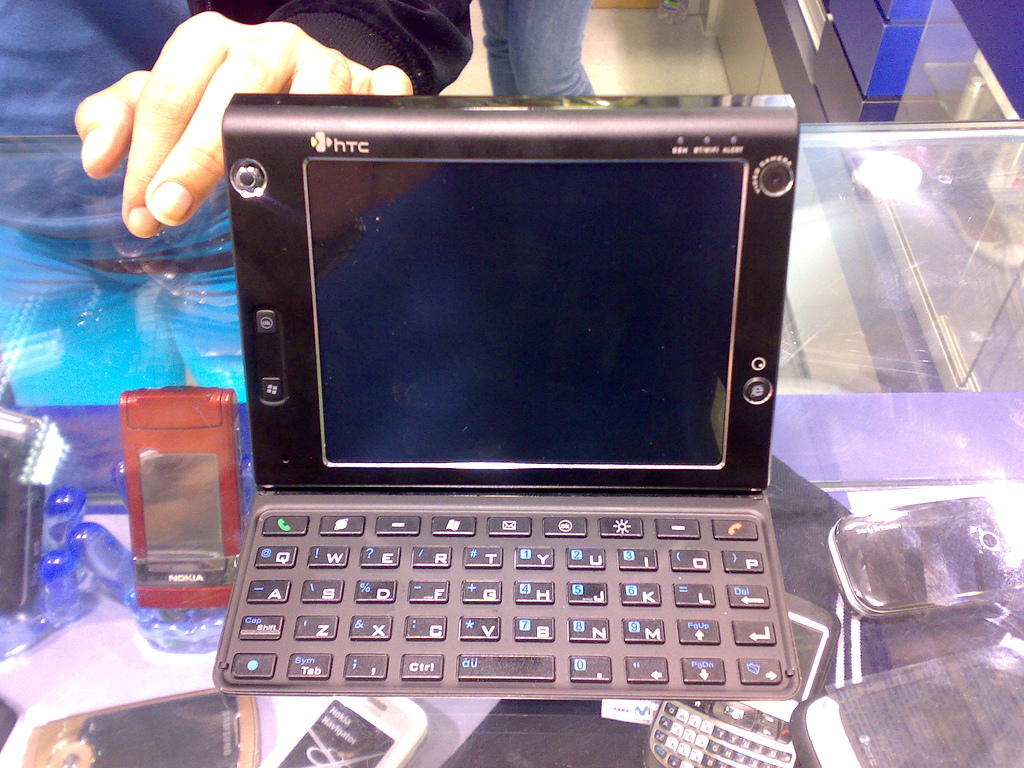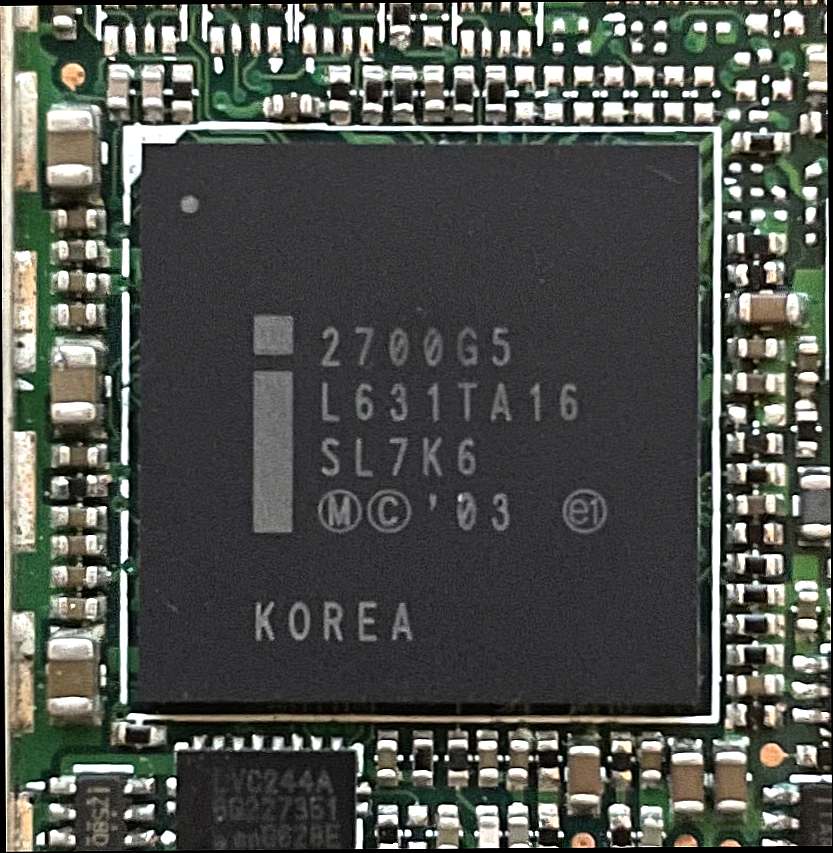|
Imageon
Imageon (previously ATI Imageon) was a series of media coprocessors and mobile chipsets produced by ATI (later AMD) in 2002–2008, providing graphics acceleration and other multimedia features for handheld devices such as mobile phones and Personal Digital Assistants (PDAs). AMD later sold the Imageon mobile handheld graphics division to Qualcomm in 2009, where it was used exclusively inside their Snapdragon SoC processors under the Adreno brand name. History Many of the Imageon processors were simply camera, multimedia, and display ISP's. Most only provided basic acceleration for 2D graphics, photo, video and audio encoding and decoding. However, they still played an essential role in enabling broad adoption of multimedia (camera and video) capabilities in featurephones, having shipped over 100 million Imageon processors by the start of 2006, and 200 million by early 2007. Since few of the early Imageon models offered full 3D hardware acceleration, ATI partnered with v ... [...More Info...] [...Related Items...] OR: [Wikipedia] [Google] [Baidu] |
ATI Technologies
ATI Technologies Inc. (commonly called ATI) was a Canadian semiconductor technology corporation based in Markham, Ontario, that specialized in the development of graphics processing units and chipsets. Founded in 1985 as Array Technology Inc., the company listed publicly in 1993. Advanced Micro Devices (AMD) acquired ATI in 2006. As a major fabrication-less or fabless semiconductor company, ATI conducted research and development in-house and outsourced the manufacturing and assembly of its products. With the decline and eventual bankruptcy of 3dfx in 2000, ATI and its chief rival Nvidia emerged as the two dominant players in the graphics processors industry, eventually forcing other manufacturers into niche roles. The acquisition of ATI in 2006 was important to AMD's strategic development of its Fusion generation of computer processors, which integrated general processing abilities with graphics processing functions within a chip. Since 2010, AMD's graphics processor pro ... [...More Info...] [...Related Items...] OR: [Wikipedia] [Google] [Baidu] |
Adreno
Adreno is a series of graphics processing unit (GPU) semiconductor intellectual property cores developed by Qualcomm and used in many of their SoCs. History Adreno (an anagram of AMD's graphic card brand ''Radeon''), was originally developed by ATI Technologies and sold to Qualcomm in 2009 for $65M, and was used in their mobile chipset products. Early Adreno models included the Adreno 100 and 110, which had 2D graphics acceleration and limited multimedia capabilities. At the time, 3D graphics on mobile platforms were commonly handled using software-based rendering engines, which limited their performance. With growing demand for more advanced multimedia and 3D graphics capabilities, Qualcomm licensed the Imageon IP from AMD, in order to add hardware-accelerated 3D capabilities to their mobile products. Further collaboration with AMD resulted in the development of the Adreno 200, originally named the AMD Z430, based on the R400 architecture used in the Xenos GPU of the Xbox ... [...More Info...] [...Related Items...] OR: [Wikipedia] [Google] [Baidu] |
HTC Advantage X7500
The HTC Advantage X7500 or HTC Athena is a Windows Mobile 5.0 Pocket PC Phone Edition based smartphone designed and manufactured by HTC. The Athena was sold by T-Mobile US under the name T-Mobile Ameo. The Ameo launched in Europe in March 2007. It was also sold under the Dopod brand as the Dopod U1000. The HTC Advantage X7501 is the Windows Mobile 6.0 version released in July 2007 as an OEM unlocked GSM phone by CompUSA and Amazon.com primarily for the North American market as a Pocket PC. It does not have the second camera which the Advantage X7500 has for videoconferencing. The HTC Advantage X7510 is an updated version of the X7500, featuring Windows Mobile 6.1 "Manilla" Professional and solid state, 16GB flash drive. The X7510 model also brings back the secondary VGA camera on the screen side for videoconferencing Videotelephony, also known as videoconferencing and video teleconferencing, is the two-way or multipoint reception and transmission of audio and video signal ... [...More Info...] [...Related Items...] OR: [Wikipedia] [Google] [Baidu] |
BitBoys
Bitboys Oy was a hardware development and licensing company based in Finland, founded in 1991 and acquired by ATI Technologies for up to US$44M on May 2, 2006. Until the acquisition, Bitboys had focused on mobile phone gaming, and had developed a large vector graphics-related portfolio. Bitboys was formed by some of the members of the demogroup Future Crew. Bitboys became infamous after the 1999 announcement of their Glaze3D series of graphics cards, which later turned out to be vaporware. When Infineon Technologies shut down its embedded DRAM production line, Bitboys quickly transformed from PC desktop graphics chip business to mobile graphics IP business. They could not find another manufacturer capable of producing the part because of the high amount of embedded DRAM used. After the merger of ATI into the AMD Graphics Product Group, the entire BitBoys Oy team was acquired by Qualcomm on January 22, 2009, following the sale of AMD Imageon Imageon (previously ATI Imageon) ... [...More Info...] [...Related Items...] OR: [Wikipedia] [Google] [Baidu] |
GoForce
The Nvidia GoForce was a line of chipsets that was used mainly in handheld devices such as PDAs and mobile phones. Nvidia acquired graphics display processor firm MediaQ in 2003, and rebranded the division as GoForce. It has since been replaced by the Nvidia Tegra series of SoCs. Features GoForce 2100 Featuring VGA image capture, 2D graphics acceleration, JPEG support, and MJPEG acceleration. Used in the Samsung SCH-M500 Palm OS based flip-phone. GoForce 2150 Featuring 1.3-megapixel camera support, JPEG support, and 2D graphics acceleration. Supports 3-megapixel images with the upgrade. GoForce 3000/GoForce 4000 The GoForce 4000 supports 3.0-megapixel camera and MPEG-4/H.263 codec, whilst GoForce 3000 is a low-cost version of the GoForce 4000 with limited features. GoForce 4500 Features 3D graphics support with a geometry processor and programmable pixel shaders, used in the Gizmondo device. GoForce 4800 Supports 3.0-megapixel camera and a 3D graphics engine. GoForce 550 ... [...More Info...] [...Related Items...] OR: [Wikipedia] [Google] [Baidu] |
Intel 2700G
Intel 2700G (code-named Marathon) is a low power (50 mW max) graphics co-processor for the XScale PXA27x processor, announced on April 12, 2004. It is built on both the PowerVR MBX Lite chip design (which is a descendant from the PowerVR2 graphics technology that powered SEGA Dreamcast) and on the MVED1 video encoder/decoder technology. Different variants This accelerator comes in 3 variants: The 2700G3, 2700G5 and 2700G7. 2700G3 The 2700G3 is the value version of the accelerator. It has 384 kB of on-die memory suitable for driving an HVGA (320×480) or smaller graphics display. 2700G5 The 2700G5 is the performance version of the accelerator. It has 704 kB of on-die memory suitable for driving a VGA (640×480) resolution display and decoding MPEG-4 video. 2700G7 The 2700G7 is the same as the 2700G5 but is stacked with 16 MB of local memory with a 100 MHz, 32-bit bus (maximum 400 MB/s theoretical bandwidth) in the same package. Features All the chips have a 75&nbs ... [...More Info...] [...Related Items...] OR: [Wikipedia] [Google] [Baidu] |
Tapwave Zodiac
The Tapwave Zodiac is a mobile entertainment console. Tapwave announced the system in May 2003 and began shipping in October of that same year. The Zodiac was designed to be a high-performance mobile entertainment system centered on video games, music, photos, and video for 18- to 34-year-old gamers and technology enthusiasts. By running an enhanced version of the Palm Operating System (5.2T), Zodiac also provided access to Palm's personal information management software and many other applications from the Palm developer community. The company was based in Mountain View, California. The Zodiac console was initially available in two models, Zodiac 1 (32MB) for US$299, and Zodiac 2 (128MB) for US$399. Some of the game titles for the product included ''Tony Hawk's Pro Skater 4'' (Activision); ''Mototrax'' (Activision); '' SpyHunter'' ( Midway); ''Madden NFL 2005'' ( EA/MDM); '' Doom II'' (id Software); '' Golden Axe III'' and ''Altered Beast'' ( Sega); '' Warfare Incorporated'' ( H ... [...More Info...] [...Related Items...] OR: [Wikipedia] [Google] [Baidu] |
OpenVG
OpenVG is an API designed for hardware-accelerated 2D vector graphics. Its primary platforms are mobile phones, gaming & media consoles and consumer electronic devices. It was designed to help manufacturers create more attractive user interfaces by offloading computationally intensive graphics processing from the CPU onto a GPU to save energy. The OpenGL ES library provides similar functionality for 3D graphics. OpenVG is managed by the non-profit technology consortium Khronos Group. History The OpenVG group was formed on July 6, 2004 by a selection of major firms including 3Dlabs, Bitboys, Ericsson, Hybrid Graphics, Imagination Technologies, Motorola, Nokia, PalmSource, Symbian, and Sun Microsystems. Other firms including chip manufacturers ATI, LG Electronics, Mitsubishi Electric, NVIDIA, and Texas Instruments and software- and/or IP vendors DMP, Esmertec, ETRI, Falanx Microsystems, Futuremark, HI Corporation, Ikivo, HUONE (formerly MTIS), Superscape, and Wow4M hav ... [...More Info...] [...Related Items...] OR: [Wikipedia] [Google] [Baidu] |
Image Processor
An image processor, also known as an image processing engine, image processing unit (IPU), or image signal processor (ISP), is a type of media processor or specialized digital signal processor (DSP) used for image processing, in digital cameras or other devices. Image processors often employ parallel computing even with SIMD or MIMD technologies to increase speed and efficiency. The digital image processing engine can perform a range of tasks. To increase the system integration on embedded devices, often it is a system on a chip with multi-core processor architecture. Function Bayer transformation The photodiodes employed in an image sensor are color-blind by nature: they can only record shades of grey. To get color into the picture, they are covered with different color filters: red, green and blue ( RGB) according to the pattern designated by the Bayer filter - named after its inventor. As each photodiode records the color information for exactly one pixel of the image, ... [...More Info...] [...Related Items...] OR: [Wikipedia] [Google] [Baidu] |
OpenGL
OpenGL (Open Graphics Library) is a cross-language, cross-platform application programming interface (API) for rendering 2D and 3D vector graphics. The API is typically used to interact with a graphics processing unit (GPU), to achieve hardware-accelerated rendering. Silicon Graphics, Inc. (SGI) began developing OpenGL in 1991 and released it on June 30, 1992; applications use it extensively in the fields of computer-aided design (CAD), virtual reality, scientific visualization, information visualization, flight simulation, and video games. Since 2006, OpenGL has been managed by the non-profit technology consortium Khronos Group. Design The OpenGL specification describes an abstract API for drawing 2D and 3D graphics. Although it is possible for the API to be implemented entirely in software, it is designed to be implemented mostly or entirely in hardware. The API is defined as a set of functions which may be called by the client program, alongside a set of ... [...More Info...] [...Related Items...] OR: [Wikipedia] [Google] [Baidu] |
OpenGL ES
OpenGL for Embedded Systems (OpenGL ES or GLES) is a subset of the OpenGL computer graphics rendering application programming interface (API) for rendering 2D and 3D computer graphics such as those used by video games, typically hardware-accelerated using a graphics processing unit (GPU). It is designed for embedded systems like smartphones, tablet computers, video game consoles and PDAs. OpenGL ES is the "most widely deployed 3D graphics API in history". The API is cross-language and multi-platform. The GLU library and the original GLUT are not available for OpenGL ES, freeglut however, supports it. OpenGL ES is managed by the non-profit technology consortium Khronos Group. Vulkan, a next-generation API from Khronos, is made for simpler high performance drivers for mobile and desktop devices. Versions Several versions of the OpenGL ES specification now exist. OpenGL ES 1.0 is drawn up against the OpenGL 1.3 specification, OpenGL ES 1.1 is defined relative to the O ... [...More Info...] [...Related Items...] OR: [Wikipedia] [Google] [Baidu] |




